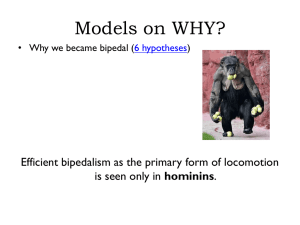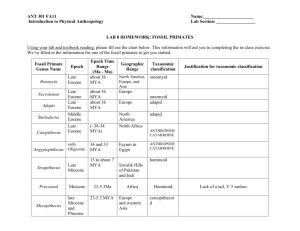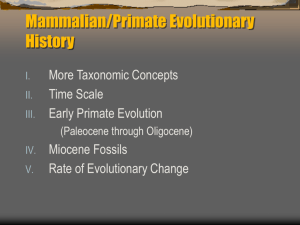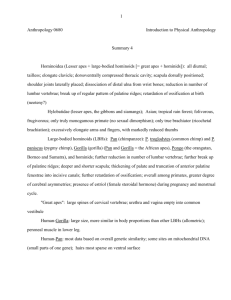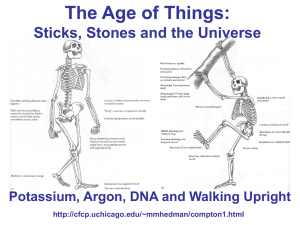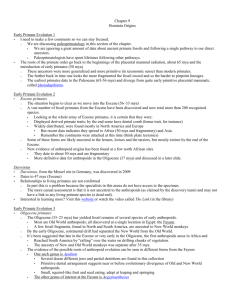Miocene Hominoid Distribution, From Fossils Thus Far Discovered
advertisement
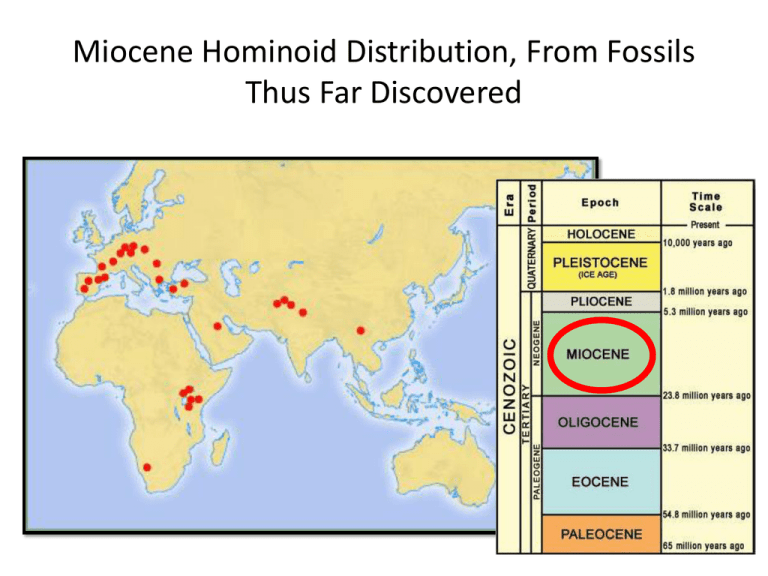
Miocene Hominoid Distribution, From Fossils Thus Far Discovered Miocene Hominoid Fossils 1. These hominoids are more closely related to the ape-human lineage than Old World monkeys. 2. Mostly large-bodied hominoids, more akin to the lineages of orangutans, gorillas, chimpanzees, and humans. 3. Most of the Miocene forms discovered are so derived that they are probably not ancestral to any living form. Miocene Fossil Hominoids African forms (23–14 mya) – Especially from western Kenya, these hominoids are, in many ways, primitive. – Proconsul Miocene Fossil Hominoids European forms (16–11 mya) – From scattered localities in France, Spain, Italy, Greece, Austria, Germany, and Hungary, most are quite derived. – Dryopithecus and Ouranopithecus Miocene Fossil Hominoids Asian forms (16–7 mya) – The largest and most varied group from Turkey through India/Pakistan and east to southern China, most are highly derived. – Sivapithecus Sivapithicus Sivapithecus (from Turkey and Pakistan) shows facial features similar to the modern orangutan, suggesting a fairly close evolutionary link. Orangutan chimpanzee • Sivapithecus Note the dished face, broad cheekbones, and projecting upper jaw and incisors on both Sivapithecus and the Orangutan From Primate ancestors to… Hominins Hominins (us) review… • Defined by dental features, bipedal locomotion, large brain size, and tool making behavior • Characteristics that developed at different rates, called mosaic evolution Biocultural Evolution: The Human Capacity for Culture • All aspects of human adaptation, including technology, traditions, language, religion, marriage patterns, and social roles. • Culture is a set of learned behaviors; it is transmitted from one generation to the next through learning and not by biological or genetic means. • Material culture is part of the cultural complex… Oldowan Tool Industry • The Oldowan is the first known industrial complex in prehistory. It takes its name from Olduvai Gorge, Tanzania Chopping tool • Oldowan tool use is estimated to have begun about 2.5 million years ago (mya), lasting to as late as 0.5 mya. • It is thought that Oldowan tools were produced by several species of hominids ranging from late Australopithecus to early Homo. Biface tool Anthropologists who study this stuff… • Paleoanthropologists. They study early humans. • Paleoanthropologists reconstruct the anatomy, behavior, and ecology of our ancestors: • It is a diverse multidisciplinary pursuit seeking to reconstruct every bit of information possible concerning the dating, anatomy, behavior, and ecology of our hominin ancestors. • Locate early hominin sites, collect faunal remains and artifacts Dating (relative) • Relative dating methods. These tell you that something is older or younger than something else – Stratigraphy- based on the law of superposition, which states that a lower layer is older than a higher one – Flourine analysis, used to date remains of bone – Biostratigraphy – paleomagnetism Dating (absolute) • Absoulte dating methods – Chronometric (Absolute) dating methods are based on calendar years – K/Ar, or potassium argon method used to date materials in the 5-1 mya range – Carbon-14 method used to date organic material extending back to 75,000 years – Thermoluminescence – Uranium series dating – Electron spin resonance (ESR)
